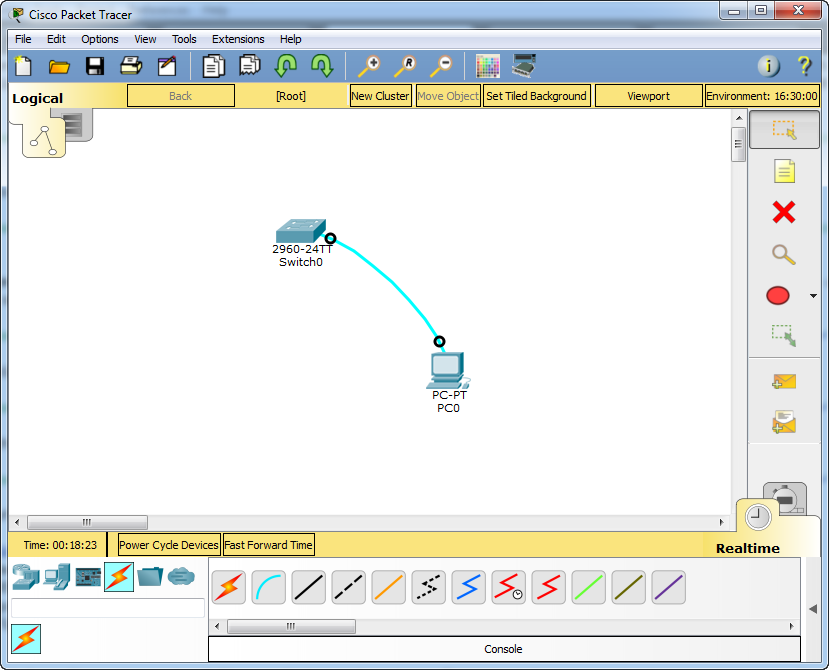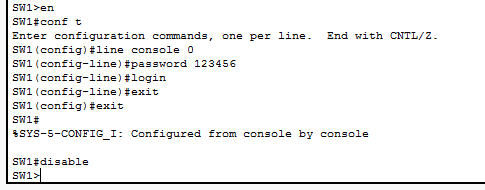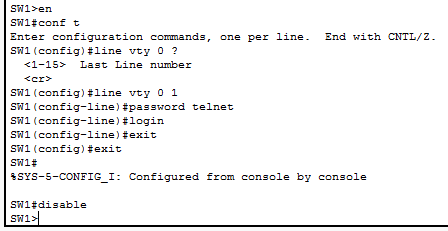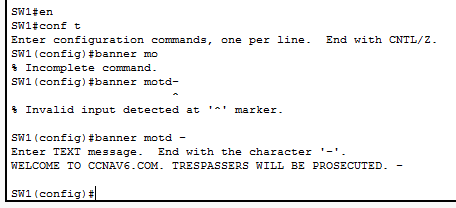Basic Configuration of a Cisco router or Switch
Basic configuration of a Cisco switch can be done in three ways, using Cisco Device manager web tool, Using Cisco Networking Assistant (CNA) and Cisco IOS setup mode. The first two are GUI tools and the latter is a CLI option. Since Cisco IOS plays a very important part in CCNA exam, we are going to see how to configure a switch using Cisco IOS setup mode commands. In this chapter, we are going to configure the name of the switch, set management IP address to the switch, configure console and telnet passwords and lastly configure message of the day banner for the switch. To configure a Cisco switch using Cisco IOS, we must connect a computer to the console port of the switch using a rollover cable. We will simulate the same thing in Packet Tracer. Connect as shown below.

Naming the switch:
Naming the switch can ease management and identification of the switch. Run the following commands for naming the switch. A switch can be named using “hostname” command.

The first two commands allow us to access the global configuration of the switch. The “hostname” command renames the switch. The rest of the commands are used to exit from global configuration mode.
Configure management IP address:
Configuring management IP address to the switch or router allows us to connect to the switch or router from remote locations using either Telnet or HTTP. To configure management IP address on the switch, run the following commands.

The first two commands (“en” and “conf t”) set the IOS in privileged global configuration mode. This mode enables us to run commands that configure switch settings that apply to the whole switch.
The “interface vlan1” command selects an interface to work with. VLAN 1, is called the management VLAN and is reserved for management of the switch. We set IP address and the management default IP gateway on this VLAN.
“ip address 10.10.10.3 255.0.0.0” command sets the IP address and the subnet mask of the switch on interface vlan1. The no shutdown command turns on the interface vlan1. The exit command brings us back into global configuration mode from specific configuration mode.
The “ip default-gateway 10.10.10.1” command sets the default gateway of the switch to 10.10.10.1. We can see that we first exit from the interface configuration mode (( config-if)# exit) because the default gateway applies to the whole switch, not just to an interface.
Configuring Console password:
To set up a console password on the switch, run the following commands.

The “line console 0” command selects the console line. There is only one console line on a cisco switch. The “password 123456” command sets the password of the console line to 123456. The “login” command instructs the IOS to prompt for authentication when somebody logs into console line.
Configuring telnet password:
configure telnet password on the switch, run the following commands.

The “line vty 0 ?” command shows the number of vty lines available on the switch. The response < 1-15 > shows that 15 VTY lines are available, which means we can have 15 simultaneous sessions on this switch. We will configure telnet password on line 1. The “line vty 1” command selects the line 1. The “password telnet” command sets the telnet password of the line to telnet. The “login” command instructs the IOS to prompt for authentication.
Configuring banners:
Banners can be used to display a brief message about the switch when someone logs in. It helps identifying the switch we log into and its configuration and usage guidelines. We can also add a security warning in the banner message to warn users against unauthorized access to the switch. We should run the following commands to configure banners on the switch.

We will configure message of the day on the switch. The “banner motd -“ command ( note that there is a space between motd and – ) is used to configure the message of the day banner on the switch. When we run this command, it prompts us to enter the message which should be ended by -.
That ends our basic configuration of the switch.

Dont put “welcome” in any banner you set it’s bad itsec
Thank you very much indeed!
NICE